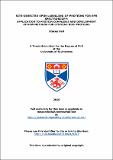Files in this item
Site-directed spin-labelling of proteins for EPR spectroscopy : application to protein complexes and development of new methods for cysteine rich proteins
Item metadata
| dc.contributor.advisor | Lovett, Janet Eleanor | |
| dc.contributor.author | Bell, Stacey | |
| dc.coverage.spatial | 249 | en_US |
| dc.date.accessioned | 2016-02-15T16:56:03Z | |
| dc.date.available | 2016-02-15T16:56:03Z | |
| dc.date.issued | 2016-06-22 | |
| dc.identifier | uk.bl.ethos.680803 | |
| dc.identifier.uri | https://hdl.handle.net/10023/8237 | |
| dc.description.abstract | The work described in this thesis is an experimental study into the application of Electron Paramagnetic Resonance (EPR) Spectroscopy for the study of biological systems. Using a variety of methods of site-directed spin-labelling (SDSL), this thesis aims to explore long range structure in an assortment of recombinant and native proteins, and complexes thereof. The work described in this thesis covers all aspects of the work, from experimental design, molecular biology and cloning, protein expression and purification, as well as functional characterisation, and finally EPR distance measurements, data analysis and interpretation. Challenges and pitfalls will also be addressed. Chapters 1 and 2 introduce EPR spectroscopy, and its application in the study of long range structure in biological systems. The experimental techniques employed throughout this thesis are also introduced. Chapter 3 details an investigation into the complement C3b:factor H complex. This chapter addresses the challenges associated with the SDSL of cysteine rich proteins. Utilising hidden cysteine residues in native proteins for spin-labelling purposes will also be addressed. Chapter 4 looks at the interactions of the human myosin regulatory light chain (RLC) with cardiac myosin binding protein C (cMyBP-C). Optimisation of expression and purification protocols will be the focus, as well as addressing issues with protein solubility and spin labelling efficiencies. Chapter 5 explores the development of new methods of SDSL, for the specific labelling of cysteine rich proteins. The ability of Escherichia coli to read through the amber stop codon will be exploited for the incorporation of unnatural amino acids for labelling purposes, and novel spin labels, specific for labelling cysteine pairs tested in several model systems. Furthermore, native paramagnetic centres in recombinant proteins will be explored as potential labelling sites. | en_US |
| dc.language.iso | en | en_US |
| dc.publisher | University of St Andrews | |
| dc.subject | Protein structure | en_US |
| dc.subject | Magnetic resonance | en_US |
| dc.subject | Electron paramagnetic resonance | en_US |
| dc.subject | Complement | en_US |
| dc.subject | Myosin | en_US |
| dc.subject | Myoglobin | en_US |
| dc.subject | Unnatural amino acids | en_US |
| dc.subject.lcc | QP519.9E433B4 | |
| dc.title | Site-directed spin-labelling of proteins for EPR spectroscopy : application to protein complexes and development of new methods for cysteine rich proteins | en_US |
| dc.type | Thesis | en_US |
| dc.type.qualificationlevel | Doctoral | en_US |
| dc.type.qualificationname | PhD Doctor of Philosophy | en_US |
| dc.publisher.institution | The University of St Andrews | en_US |
This item appears in the following Collection(s)
Items in the St Andrews Research Repository are protected by copyright, with all rights reserved, unless otherwise indicated.

